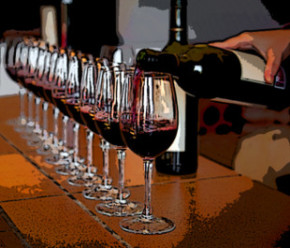The Wine Tasting Stream of Consciousness.
Chapter Four. Part Three.
 It’s wine tasting season in New York once again. A season-ending injury kept me out of the fall tasting line-up and at the first spring event I started slurring my speech, dropped several wine glasses and fell down twice. I became disoriented, dizzy and incoherent so I did the only sensible thing.
It’s wine tasting season in New York once again. A season-ending injury kept me out of the fall tasting line-up and at the first spring event I started slurring my speech, dropped several wine glasses and fell down twice. I became disoriented, dizzy and incoherent so I did the only sensible thing.
I drove myself straight home.
Years ago, when I first started attending wine tastings, I developed an olfactory/gustatory associative process to try to pinpoint the flavors and aromas that seemed so familiar yet so elusive. The first time I recognized the taste of vanilla in a red wine is a good illustration of how this free flowing stream of consciousness unfolds.
I swished a Leonetti Cellars Merlot around my mouth and I remember thinking, “I taste chocolate in this wine…it’s not dark or roasted like cocoa or tiramisu … it’s lighter, closer to milk chocolate… no wait, it’s lighter than that… it’s like white chocolate… hold on now, it’s even lighter than that. It’s not cocoa, not dark chocolate, not milk chocolate, not white chocolate, it’s lighter still, it’s… it’s…. it’s VANILLA.” That’s when I had the “Eureka moment!” That’s the moment you recognize a flavor or aroma in wine and make an association with something in your olfactory memory banks.
I also had the Eureka moment! when I first tasted coconut in wine. I was sampling a Cabernet Sauvignon that had been aged in heavily toasted American oak barrels. I kept thinking, “This wine tastes like cocoa… no, it tastes more like nuts… no, like cocoa… no, nuts…cocoa… nuts… COCONUTS.” Eureka moment! I never realized that coconuts taste like a combination of cocoa and nuts until this wine made me aware of it. Today when I smell a coconut I think, “This thing smells like Cabernet Sauvignon aged in American oak”.
Aromas like coconut, dill or chocolate can be very obvious to some tasters and so indefinable to others. An associate of mine I’ll call Jon (because that’s his name) has been in the wine trade for over thirty-five years. He told me that for most of his career he didn’t understand the association between wine and chocolate. That’s because he hadn’t experienced a wine/chocolate Eureka moment!
One day Jon was tasting wine with a French winemaker I’ll call Francois when it happened. Jon tasted Francois’ wine and (wait for it … ) Eureka moment! he recognized the distinctive flavor of chocolate in the wine.
“Oh my God” he said. “I taste chocolate in this wine! It’s so clear. It’s so obvious. Why could I never taste chocolate before when it is so incredibly apparent to me now?”
The winemaker replied, “Yes, but there are many deefferent kinds of schocolat. Wheech one do you taste?”
There are three points to these stories. Point one; Francois is a putz.
Point two; the chocolate flavor found in the wine is not obvious, after all, this is wine we’re describing and not Cocoa Puffs. If it were obvious, everyone could take one sip of wine and think, “This wine tastes like chocolate. Why do I need WineSnark to tell me what to think? That’s my wife’s job.”
You won’t always experience the Eureka moment! More often you will find a flavor or aroma is vaguely reminiscent of chocolate, it is somehow similar to chocolate or it has a fleeting familiarity with chocolate. That’s why so many wine descriptions use terms like hint, subtle, nuance or WTF.
When Jon finally made the association between the flavor in his glass and his memory of chocolate, it became immensely clear to him and from that moment on the comparison was much easier to make. You will also notice that once you make the link between a flavor in wine and one of your database memories, that association becomes infinitely easier to identify in future wines. It’s like the ancient mathematician Archimedes said, “Describing wine is as easy as Pi.”
Point three; there’s no need to stop at simple associations. Your palate is capable of intricate distinctions and you can use the associative stream of consciousness to narrow down your observations. When you taste a wine that reminds you of chocolate, ask yourself, “Does this remind me of dark chocolate, milk chocolate, or white chocolate? Is it really Chocolate I taste or something similar such as mocha, carob or caramel?”
As you learn to fine-tune your descriptions you can use your new skills to impress winemakers when tasting season rolls around. Although I should warn you, tasting wine with winemakers isn’t nearly as much fun as you might think. At a recent tasting, one serious winemaker said to me, “This wine has hints of 2,4,6 trichloroanisole.”
I said, “You mean it’s corked?”
“Yes that’s it,” said the winemaker. “I can never remember that word.”





















Love your style of writing! Wine should be fun and its folks like you that make the wine world enjoyable with of course lots of wine itself! ; )
Thanks Jennifer! I try to be serious but the voices in my head tell me if I don’t print what they say, they’ll start killing off my brain cells one at a time.
No I think thats the wine killing the brain cells
Uh oh. I’m in big trubl sd@$ 3 N* % b# …